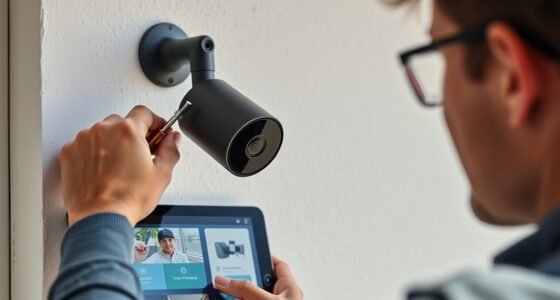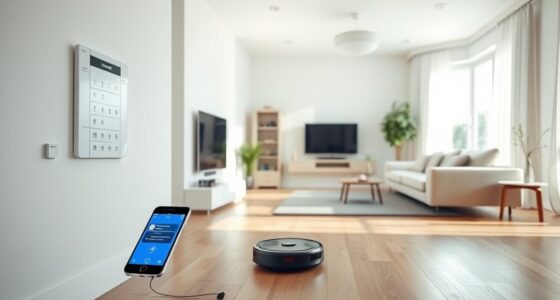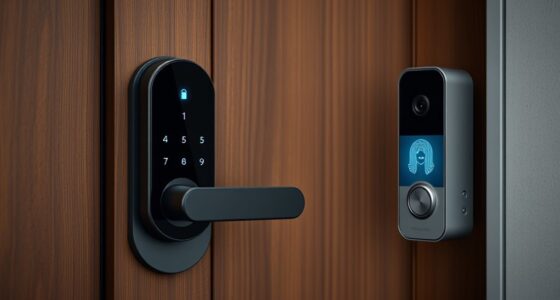Whether you need a smart home hub depends on your routines and devices. A hub simplifies managing multiple gadgets, offers centralized control, and allows automation, which can boost convenience and energy efficiency. However, it can also be costly and introduce security risks if not properly protected. If you prioritize ease of use, device compatibility, and future expansion, a hub might be worth considering. To find out which option suits your lifestyle best, continue exploring your choices.
Key Takeaways
- A smart home hub centralizes device control, simplifying management and automation, but isn’t essential for basic smart device operation.
- Hubs enhance compatibility across brands and protocols, supporting future expansion, though many devices now work independently without hubs.
- Using a hub can improve security through centralized updates but also presents a single point of failure and potential cybersecurity risks.
- Hub-free setups offer easier installation and flexibility, but managing multiple devices individually can be more complex and time-consuming.
- The decision depends on your automation needs, device ecosystem, and preference for centralized control versus simplicity.
Understanding What a Smart Home Hub Is
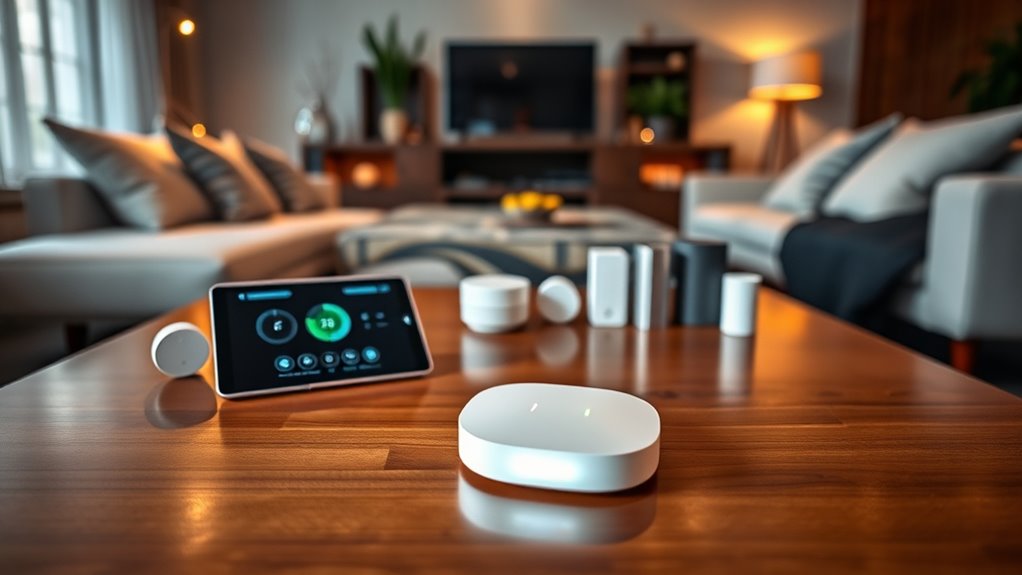
A smart home hub is a centralized device that connects and manages various smart devices in your home, allowing them to work together seamlessly. It enhances your smart home aesthetics by reducing clutter, as you won’t need multiple controllers scattered throughout your space. With a hub, you get streamlined control via a single interface, often integrated with voice control options like Alexa, Google Assistant, or Siri. This means you can simply speak commands to turn on lights, adjust thermostats, or lock doors, making your life more convenient. The hub acts as the brain, coordinating different brands and devices, so they function harmoniously. Whether you have smart bulbs, cameras, or sensors, a hub helps unify these elements into a cohesive, easily manageable system. Additionally, understanding compatibility between devices ensures your smart home operates smoothly and efficiently. Incorporating device integration can further optimize your setup by enabling more complex automation routines and personalized control.
How a Hub Simplifies Device Management
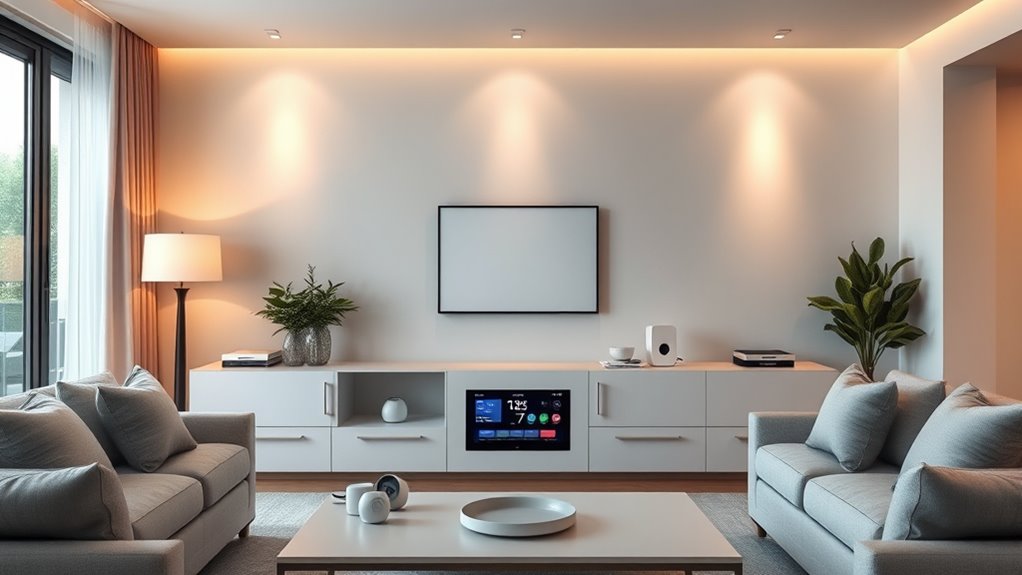
By centralizing control, a smart home hub makes managing multiple devices straightforward and efficient. Instead of juggling individual apps, you can use voice control to command all connected devices through a single interface. This simplifies daily routines, allowing you to turn lights on, adjust thermostats, or lock doors with just your voice. The hub also offers remote access, so you can monitor and control your smart home from anywhere, whether you’re at work or on vacation. This eliminates the need to open multiple apps or log into different accounts. With everything integrated into one system, managing your smart devices becomes more intuitive and less time-consuming. Additionally, understanding device compatibility ensures that all your smart devices work seamlessly together within the hub. Proper setup and integration can prevent device conflicts and enhance overall system stability. Regular software updates further improve system security and functionality, ensuring your smart home remains safe and efficient. A well-designed hub can also support integration with other smart devices, broadening your automation possibilities. Overall, a hub streamlines device management, giving you greater convenience and control over your smart home environment.
Compatibility Across Devices and Ecosystems
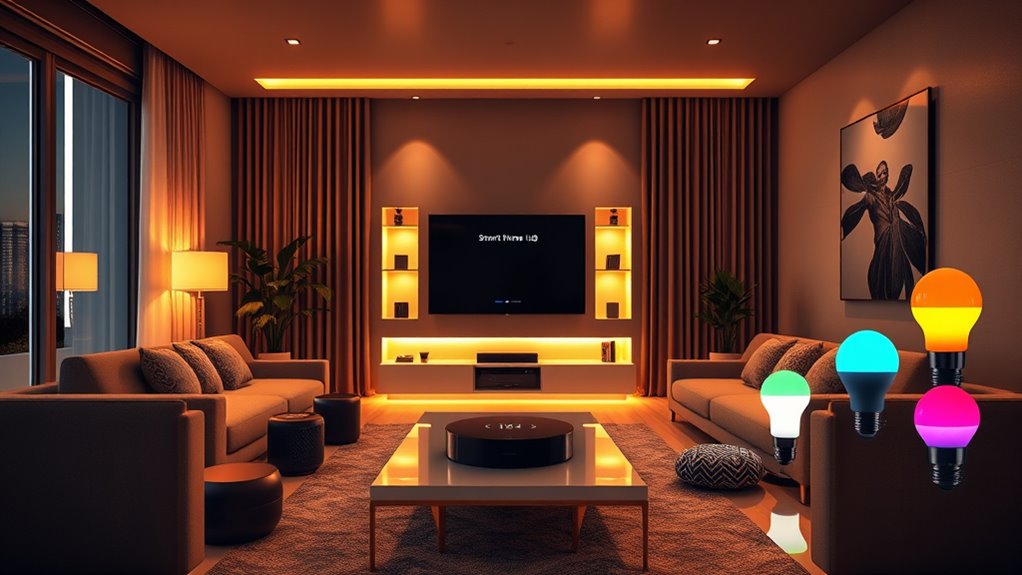
Ensuring your smart home hub works seamlessly across various devices and ecosystems is essential for a truly integrated experience. Compatibility enables you to control different smart devices using a single interface, making voice control more effective. When your hub supports multiple ecosystems, you can connect smart lights, thermostats, and security cameras regardless of their brand. This device integration reduces the need for multiple apps and simplifies management. Additionally, some hubs offer platform compatibility, allowing for a broader range of device integration and future expansion options. However, not all hubs offer universal compatibility, so you might face limitations if you prefer specific brands or platforms. Before choosing a hub, check which devices and ecosystems it supports to guarantee smooth operation. Device compatibility plays a crucial role in achieving a cohesive smart home setup. A compatible hub enhances your smart home’s convenience and responsiveness, making your automation efforts more effective and enjoyable. Ensuring your hub supports standard protocols can also improve reliability and ease of use across your device network.
Enhancing Automation and Routine Customization

Enhancing automation and routine customization allows you to tailor your smart home experience to fit your daily habits perfectly. With a hub, you can set up complex routines that trigger multiple actions simultaneously, making your life easier. Voice control becomes more powerful, letting you activate scenes or routines with a simple command. Device grouping is essential here; it lets you organize related devices into categories, so you can control everything at once—like dimming lights and adjusting the thermostat with a single command. This level of customization ensures your smart home responds exactly how you want, improving convenience and efficiency. Additionally, wall organization systems can help you keep your device setups neat and accessible, further enhancing your smart home environment. By centralizing control, a hub helps you create seamless routines that save time and effort while enhancing your overall smart home experience.
Cost Implications of Investing in a Hub
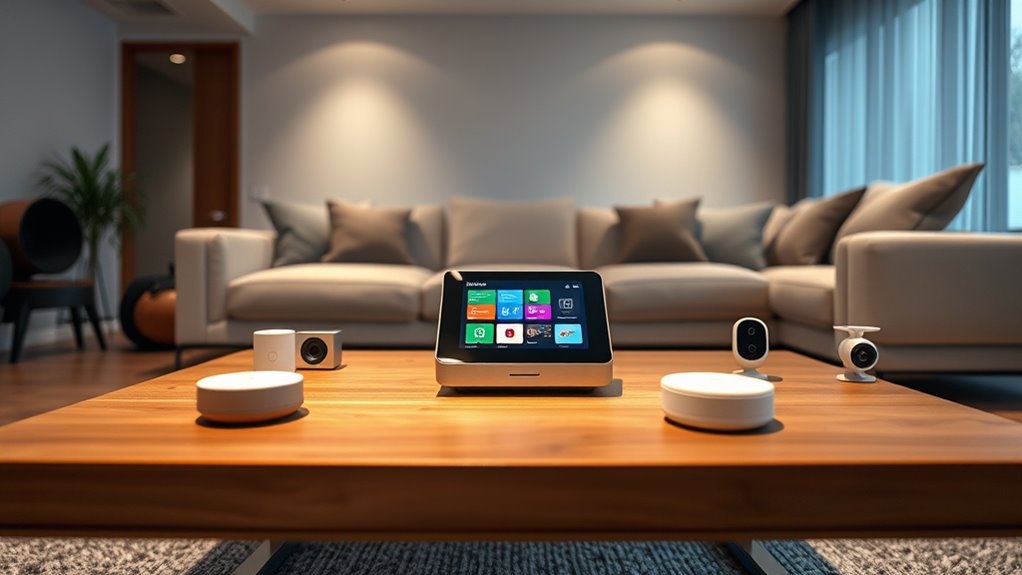
Investing in a smart home hub involves upfront costs that can vary widely depending on features and brand. To make informed decisions, you should do a thorough cost comparison of different models to find one that fits your budget. Keep in mind that more advanced hubs with extra capabilities typically come with higher price tags. Budget planning is essential to avoid overspending and ensure you’re investing wisely. Consider not only the initial purchase price but also potential additional costs, such as compatible devices or subscription services. Evaluating the cost differences between leasing and buying can help you determine the most economical option for your needs. Additionally, understanding the privacy policies associated with smart home devices can help you safeguard your personal information and ensure your privacy preferences are respected. Researching the custodian services for managing your smart home investments can enhance your overall security and compatibility. Being aware of potential cost-saving strategies can further help you maximize value and reduce expenses over time. By evaluating these factors early, you can determine whether a smart home hub aligns with your financial situation and long-term goals. Being clear about costs helps you maximize value and avoid surprises down the line. Additionally, understanding the Fokos privacy and cookie policies can help you manage your online data and advertising preferences effectively.
Privacy and Security Considerations
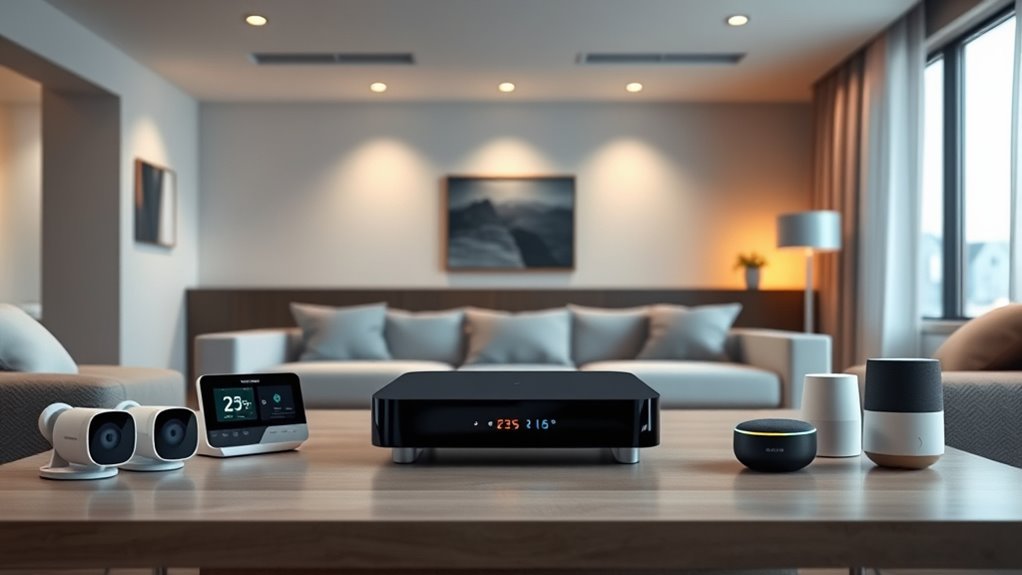
While smart home hubs offer convenience, they also raise significant privacy and security concerns that you should carefully consider. These devices collect and transmit sensitive data, making data privacy a major issue. If not properly secured, hackers could exploit vulnerabilities, leading to cybersecurity risks like unauthorized access or control over your smart devices. To protect yourself, ensure your hub has strong, unique passwords and regularly update its firmware. Be cautious about sharing personal information and review privacy settings frequently. Additionally, understanding security vulnerabilities associated with smart home devices can help you better safeguard your personal information. Implementing automation protocols can also help detect unusual activities indicative of potential threats. Staying informed about common cyber threats specific to smart home technology can further enhance your security measures. Being aware of penetration testing methods can help identify weaknesses before malicious actors do. Remember, a compromised hub can give cybercriminals access to your entire smart home, risking your safety and privacy. Staying vigilant and understanding these risks helps you make informed decisions about integrating a hub into your smart home system.
The Flexibility of a Hub-Free Smart Home Setup
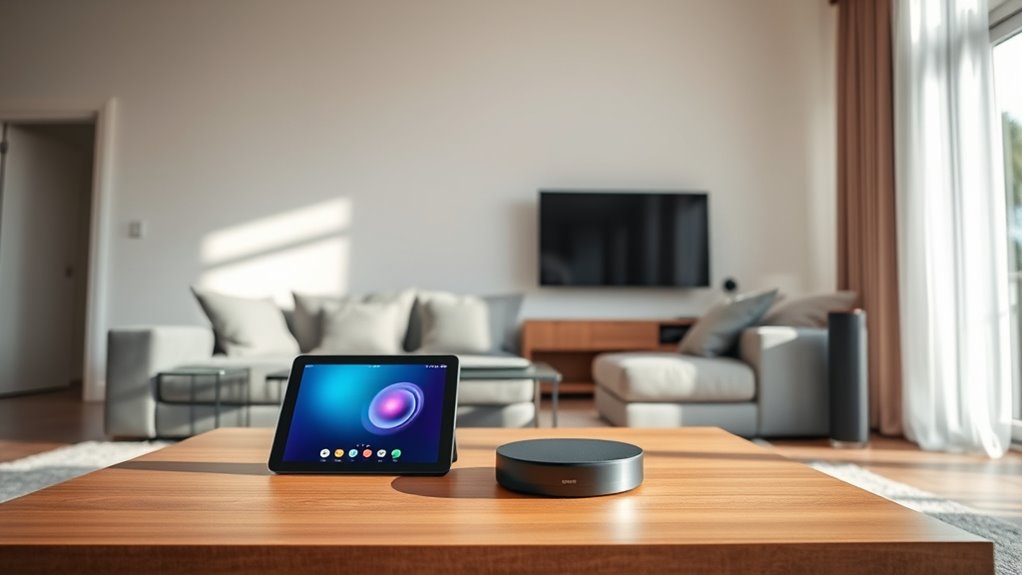
A hub-free smart home setup offers notable advantages regarding flexibility and simplicity. Without a central hub, you can easily add or remove devices, often without complex configurations. Voice control becomes more seamless, as many smart devices now support popular voice assistants directly, eliminating the need for an intermediary. This setup also enhances remote access since devices connect directly to your Wi-Fi network, allowing you to control them from anywhere via smartphone apps. You’re not limited by compatibility issues between different hubs or ecosystems, giving you more freedom to choose devices that suit your needs. Additionally, understanding best modern toilet features and maintenance can inform your decisions about home upgrades beyond smart technology. For example, selecting devices with interoperability features ensures smoother integration and future expansion. Incorporating fire safety measures into your smart home setup can further enhance safety and security. Overall, a hub-free system provides a straightforward, adaptable experience, making it easier to customize your smart home without the constraints of a centralized hub.
Troubleshooting and Maintenance Challenges
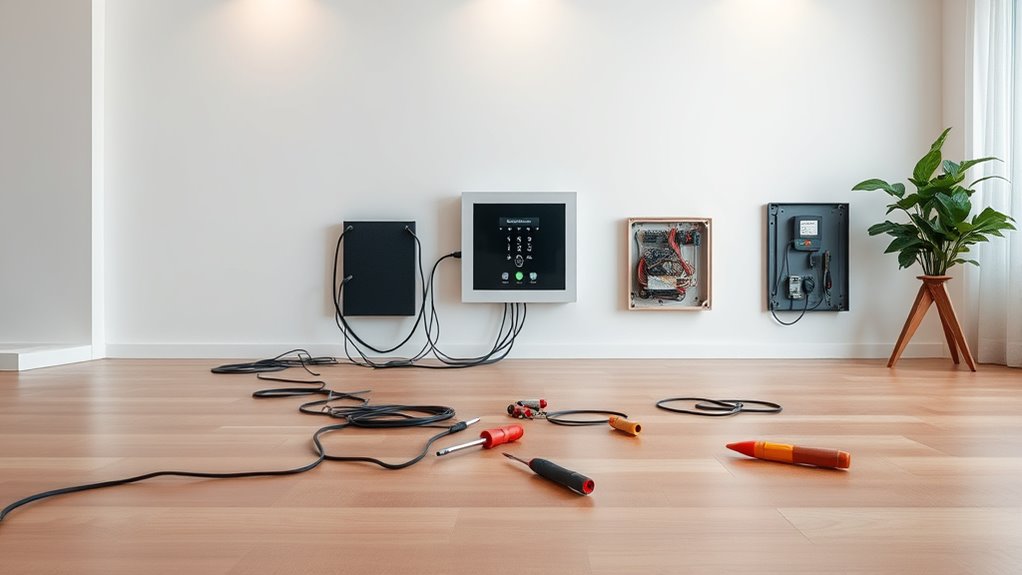
Without a central hub to coordinate devices, troubleshooting and maintenance can become more challenging. When issues arise, pinpointing the source—whether firmware bugs or hardware failures—takes more effort. Without a hub, each device often requires individual attention, making updates and fixes more time-consuming. Firmware bugs can cause devices to malfunction or disconnect unexpectedly, and without a centralized system, identifying and resolving these glitches becomes cumbersome. Hardware failures in one device might ripple through your setup, but tracking the problem and finding effective solutions is harder without the hub’s unified interface. Additionally, maintaining multiple devices individually increases the risk of inconsistencies and overlooked updates, leading to ongoing reliability issues. Regular use of a Glycolic Acid product can also introduce more variables that need monitoring and adjustment. Overall, managing your smart devices without a hub demands more patience and technical know-how.
Future-Proofing Your Smart Home Investment
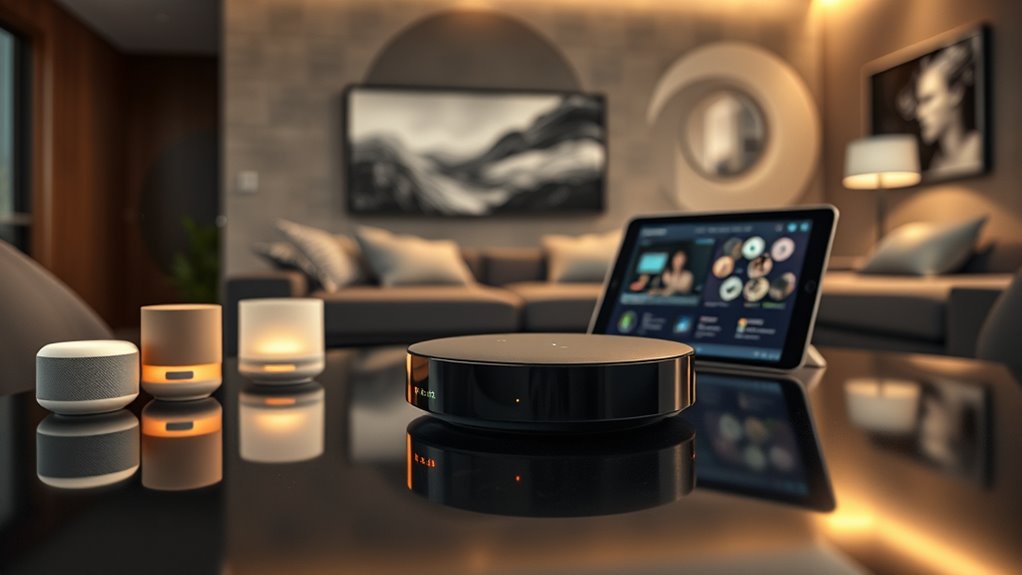
To protect your smart home investment, you need to contemplate how well your hub will stay compatible with new devices and software updates. Think about whether it can adapt to emerging technologies and integrate seamlessly as your system grows. Planning for future compatibility now saves you time and money later.
Compatibility With New Devices
Ensuring your smart home hub can work seamlessly with future devices is essential for protecting your investment. Compatibility with new devices means your system stays flexible and up-to-date, avoiding the need for costly replacements. Look for hubs that support popular voice control platforms like Alexa, Google Assistant, or Apple HomeKit, which often expand their device compatibility over time. This flexibility allows you to add new smart devices easily and integrate them smoothly. Additionally, remote access features ensure you can control your devices from anywhere, making future upgrades more practical. A hub that’s compatible with upcoming devices saves you money and effort, keeping your smart home ecosystem current without frequent overhauls. Prioritizing compatibility helps future-proof your investment, providing long-term convenience and peace of mind.
Software Update Longevity
A smart home hub that receives regular software updates can considerably extend its lifespan and functionality. These updates improve security, fix bugs, and add new features, enhancing your investment’s longevity. Without timely updates, your device may face compatibility issues, leading to device integration challenges over time. To maximize software update longevity, look for hubs with strong developer support and a reliable update schedule. Keep in mind that infrequent updates can leave your system vulnerable or obsolete. Regular updates help ensure your smart home remains smooth and secure.
- Extended device compatibility
- Reduced security risks
- Improved system stability
- Better integration with new tech
Adaptability to Emerging Tech
Choosing a smart home hub that can adapt to emerging technologies is essential for future-proofing your investment. A versatile hub supports new features like advanced voice control, making it easier to manage your devices hands-free as technology evolves. It should also integrate energy monitoring capabilities, helping you track consumption and optimize efficiency. By selecting a hub compatible with upcoming innovations, you prevent obsolescence and ensure your smart home remains current. Look for devices that offer regular updates and open ecosystems, allowing seamless integration of future gadgets. This adaptability not only enhances convenience but also maximizes your investment’s longevity. Ultimately, choosing an adaptable hub ensures your smart home can grow with technological advancements, keeping you ahead of the curve.
Deciding If a Hub Fits Your Lifestyle and Needs
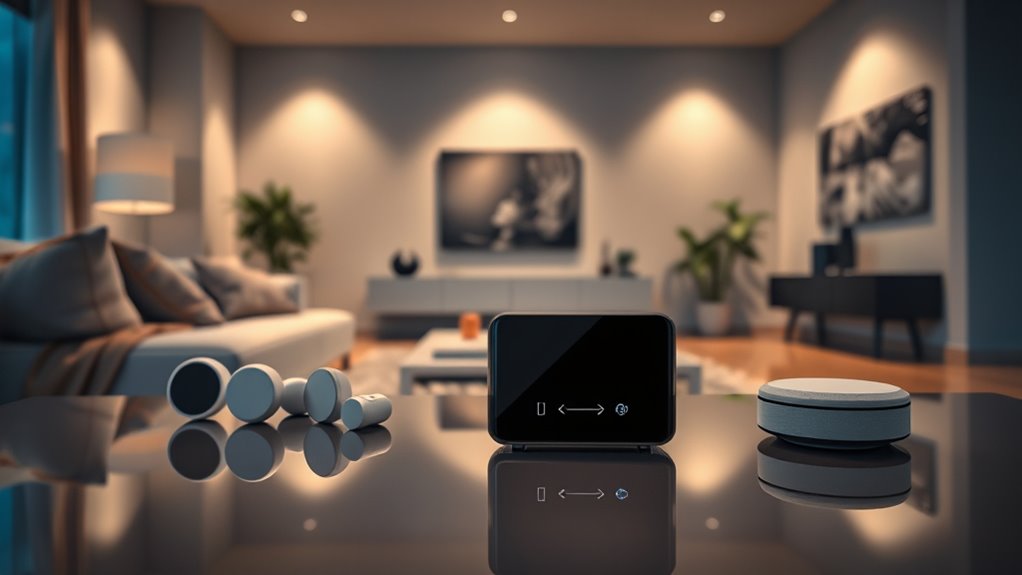
Before investing in a smart home hub, it’s vital to assess whether it aligns with your daily routines and tech preferences. Consider how a hub will impact your lifestyle, including how it integrates with your existing devices. Think about:
- Enhancing smart home aesthetics with a sleek, organized setup
- Improving energy efficiency through centralized control
- Simplifying device management and automation
- Supporting compatibility with your preferred platforms
If these benefits match your needs, a hub can streamline your smart home experience. However, if you prioritize minimalism or prefer individual device control, a hub might feel cumbersome. Reflect on your comfort with technology and your long-term goals for energy savings and aesthetics to decide if a hub truly fits your lifestyle.
Frequently Asked Questions
Can I Use Multiple Smart Home Hubs Simultaneously?
Yes, you can use multiple smart home hubs simultaneously, but it requires good multi-hub management. You’ll need to guarantee device compatibility across your hubs, so they communicate seamlessly. Managing several hubs can be tricky, but with the right setup and compatible devices, it’s doable. Just keep in mind that some integrations might be limited, so check compatibility before expanding your smart home system.
Do All Smart Devices Require a Hub to Function Properly?
Not all smart devices require a hub to work properly; many are designed to connect directly to your Wi-Fi or Bluetooth, simplifying setup and reducing costs. However, using a hub can improve device compatibility and centralize control, making management easier. Be mindful of security concerns, as hubs can be potential targets for cyber threats. Consider your device types and security needs before deciding if a hub is necessary for your smart home.
How Does a Hub Impact My Smart Home’S Energy Consumption?
A smart home hub acts like a conductor, orchestrating your devices for harmony. It can improve your energy efficiency by centralizing control, allowing better power management. However, it also consumes a bit of energy itself. Overall, if managed well, a hub helps optimize your system’s power use, preventing waste and keeping your smart home running smoothly without draining unnecessary energy.
Are Smart Home Hubs Compatible With Voice Assistants Like Alexa or Google?
Smart home hubs typically support voice assistant integration, making it easy to control your devices with Alexa or Google Assistant. They improve device compatibility by connecting different smart gadgets, ensuring seamless operation. With a hub, you can manage multiple voice assistants from a single platform, enhancing convenience. So, if you want smooth voice control and better device compatibility, a smart home hub is a great addition to your smart home setup.
What Are the Best Brands Offering Reliable Smart Home Hubs?
Did you know that over 60% of smart home users report reliability issues? When choosing smart hub brands, reliability is vital. The best options include Samsung SmartThings, Amazon Echo, and Hubitat, known for their dependability and compatibility with voice assistants like Alexa and Google. These brands offer reliable smart home hubs that minimize connectivity problems and guarantee smooth device integration, making your smart home experience seamless and efficient.
Conclusion
Think of a smart home hub as the conductor of an orchestra, bringing all your devices into harmony. When I first set one up, it felt like finally getting all the instruments to play in sync. While it simplifies management and enhances automation, it’s not for everyone. Weigh the costs and challenges against your needs. Ultimately, choosing a hub is about creating a smooth, customized symphony that fits your lifestyle perfectly.



